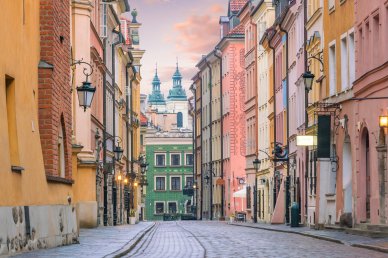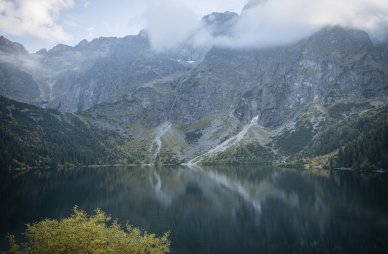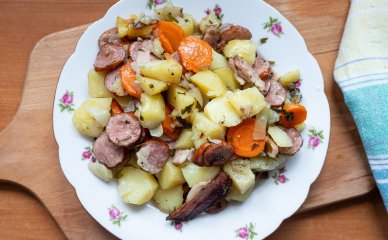Poland
A magnifying beauty, a mild European climate, eye-catching ancient architecture, and affordable prices are the impressions left on those who visit Poland for a vacation or work.
Tours to Warsaw, Krakow, or many Polish skiing resorts have become extremely popular these days.

General Information
The Polish state underwent a very difficult 1,500-year path of development starting with a small union of Western Slavic tribes and ending with a modern country that plays a significant role in the world’s politics and economy.
Its history had the eras of prosperity when a small kingdom was celebrating military successes and eventually became a fully functioning republic. There were times of turmoil when the battle-bled country lost its regions and even independence.
At present, Poland is the tenth-largest country in Europe. It is a bit too early to compare the standards of living there with the ones of Norway and the Netherlands as the sharks of wellbeing in Europe. However, in Poland, there is unfailing stability and growth even during the global recession in the time of the ongoing pandemic.
This attracts the residents of neighbouring countries like Ukraine and Belarus who seek employment in Poland, frequently even by whole families. The number of hired workers from those countries grows annually. For example, approximately 1.5 million Ukrainians and, according to various data, 50,000 - 100,000 Belarus citizens have moved to Poland in recent years.
Karta Polaka, which means Pole’s Card, greatly simplifies the migration opportunities for obtaining permanent residence.
It is the approval document that provides a multitude of rights and privileges for its holders.
Poland is good both for work and rest. Tourism is highly developed: there are lots of various skiing and health resorts aimed at family vacations.
The most famous of them are Zakopane, Arłamów, Bukowina Tatrzańska, and Szklarska Poręba.
Warsaw with a population of less than half of a million people has been the Polish capital city for more than five hundred years. In 2004, the country became a European Union member, and three years later - the member of the Schengen area.

Old town in Warsaw
Despite the EU membership, the euro has not been introduced as the official currency yet. The Polish złoty has remained the single currency since 1924, for almost a century.
Directions
Poland borders four post-Soviet states - Ukraine, Belarus, Russia, and Lithuania. And also Germany, the Czech Republic, and Slovakia. That is why getting to Poland is first of all possible from those countries.
Travelling by Bus
The most popular, quickest, and cheapest way to visit Poland is a bus tour. Comfortable buses will carry the passengers to the centres of all voivodeships and many Polish cities. However, it is highly recommended to book a bus ticket in advance because cheap trips have become very popular.
A problem of long queues at customs may emerge sometimes. So it is needed to take this into account while planning a trip, especially when time does matter.
The fans of self-guided tours frequently travel with transfers through border crossing checkpoints because this helps save on tickets. However, no facilities, long queues, and meticulous customs officers make this adventure only for the toughest.
Travelling by Train
Things would be easier if there was no Covid-19 pandemic. Borders open and close, so train connection between the European countries is very difficult to follow.
Travelling by Plane
Planes are always a good idea for those who value time and are not afraid of turbulence. For European citizens, it does not take much time to get to Poland by plane. Travellers from the other continents will enjoy some sandwiches, starters, and even beverages during long flights.
Lowcost airlines do not offer food, so it will be necessary to grab a bite before a flight. However, the ticket price is quite good - more than 20 euros.

Accommodation
Work and short-term bus tours are the two reasons why foreigners come to Poland most often. Hired workers rarely stay in hotels. Accommodation matters, as a rule, are settled on the stage of signing an employment contract with an employer.
Travel agencies deal with all the arrangements for tourists who come in groups, so they do not have problems with accommodation and food. The fans of travelling alone will need to arrange everything by themselves.
You may stay for a night or a couple of days in Warsaw, Poznan, Gdańsk, and other cities. The available options include hotels, bed-and-breakfast, camping, a hostel, or a rented apartment.
Staying in a hostel is the cheapest one. It is a youth dormitory where there are many beds, a couple of chairs, and one shared table in each room. There are a shower and toilet on every floor. This noisy and cheap place with a lot of fun is perfect for students.
The cost of a hotel room or bed-and-breakfast will vary by facilities provided and remoteness from the city centre. For example, hotels with shared kitchens cost almost the same as a place in a hostel.
A good hotel room with a bathroom will cost $50 and more per night.
Those who value comfort but do not care about the number of stars most often prefer renting an apartment. For example, five people may settle in two rooms, with or without children, and do whatever they want (obeying the Polish laws, of course).
The price of renting an apartment also differs. Somewhere in Krakow or Warsaw, it will cost not less than a hotel room. However, the competition among the landlords is fierce. So it will be possible to rent a cosy and clean apartment with a kitchen, bathroom, and toilet for $20-30 per day. Beds are comfortable, and fresh linen is provided.
Below are the facilities offered by budget hotels in Krakow and other Polish cities:
- Holiday Inn Krakow City is a very popular 5-star hotel, 1.5 kilometre from the city centre. There is the Wawel Castle and other attractions nearby. The cuisine is perfect.
- Hotel Mercure Zakopane is a country-style hotel located in Zakopane, the most known mountain ski resort. It has a swimming pool and SPA. Polana Szymoszkowa is a ten-minute walk from the hotel. The Tatra Museum is a bit further, at a three-kilometre distance.
- Cinema Hostel & Apartments (Poznan) is a nice hostel in the very heart of Old Town. It takes eight minutes to walk to Old Town Square. In 11 minutes, you will get to the Imperial Castle. And in a couple of minutes, you will find bars and restaurants with delicious food served.
- Puro Hotel (Gdańsk, Old Town) is a four-star hotel with cosy rooms. It takes from five to seven minutes to walk to St. Mary’s Church, the Long Market (Długi Targ), and Neptune’s Fountain.
- Ibis (Wrocław, suburbs) is a three-star hotel with modern rooms. There are air-conditioning and a bathroom in each room. The hotel is located close to beautiful parks, a waterpark, and Hydropolis - a famous Polish science museum.
All those places provide free Wi-Fi access.
Places to See
Castles, palaces, theatres, cathedrals, and churches make the stunning architecture a carte de visite of this country. Those representations of Gothic, Baroque, Roman, and Classic styles were built in different times, but altogether they create a unique and well-recognised image of Poland.
Nature here is magnificent: there are 23 national parks, the most known of which are Białowieża (it is also the oldest one, opened in 1947), Bieszczady, and Kampinos.

Morskie Oko lake (Eye of the Sea) at Tatra mountains in Poland
In Poland, there is a great multitude of sightseeing attractions. Each of them is beautiful in its own way, but every corner of the country has its special places that are worth being seen by tourists.
Warsaw
Old Town is the main and the biggest attraction of the Polish capital. At least a couple of hours should be spent walking across the Warsaw centre and spectating the architectural masterpieces. This part of Warsaw is included in the list of UNESCO World Heritage Sites. And rightly so!
The other must-see places are Castle Square, Royal Castle, St. Martin’s Church, Market Square. No one will remain indifferent to Warsaw Barbican, Citadel, Wilanów Palace, and Fryderyk Chopin Museum.
Families with children may enjoy visiting Copernicus Science Centre, Palace of Culture and Science, the Maria Skłodowska-Curie Museum (the first female Nobel laureate).
Krakow
It is unforgivable to skip visiting the first Polish capital while in Poland. There are so many sightseeing places that even Warsaw has fewer.
And it comes with no surprise that Krakow city centre has become one of the first places in the world to be honoured as a UNESCO World Heritage Site.
Architecture and historical monuments reflect all the happy, grand, and tragic times that the city has undergone. People from all over the world come here to see the Royal Wawel Castle and Stanislaw Lem Garden of Experiences, to honour the memory of the victims of Nazism in the Auschwitz-Birkenau Museum, and to pay tribute to human nobility and courage in the museum of former Schindler’s Enamel Factory.
Travellers will also enjoy their stay in Krakow visiting numerous arcades, shopping malls, cafes, restaurants, and bars. Beautiful horse-drawn carriages will offer rides to get a pleasant view of the city.
Arłamów
A picturesque area of the Beskids is located 50 kilometres from the Polish-Ukrainian border. It used to be a recreational facility for the leaders of socialist Poland like Edward Gierek and Wojciech Jaruzelski.
A true wild nature reserve was created there for the leaders and their distinguished guests. Entire herds of deer were grazing on that land to be then hunted.
At present, Arłamów is one of the best resorts in Poland. There is also a former state villa called Residence Hotel, a leisure centre, and cosy cafes for the visitors to this vivid place.
Tricity (Trójmiasto)
This somewhat weird word denotes three cities in the northern part of Poland - Gdansk, Gdynia, and Sopot, located on the coast of Gdansk Bay. They formed a whole metropolitan area long ago.
Residents of the cities do not have any problems travelling from city to city by bus or commuter train that constantly operate on inner routes.
A famous Crooked House and 500-metre pier - the longest in Europe - are the main Sopot attractions. The Gift of Pomerania (Dar Pomorza) Museum Ship is worth visiting in Gdynia. One should definitely go to Gdansk to see the astonishing exhibits of the Amber Museum, the Historical Museum, and the National Maritime Museum first hand.
Hel
This is the very edge of Poland, the place where the country begins. It is a perfect locality for those who aspire to quiet and lonesome rest on the sand beaches of the Polish part of the Baltic coast.
Hel will also be suitable for tourists keen on exploring new areas. Guided or self-maintained tours to the local peninsula will provide a fresh view of this land.
Food
Polish cuisine is very similar to the cuisines of its neighbouring countries. They use very simple products like eggs, buckwheat, potatoes, pork, chicken, fresh and pickled vegetables.
The names of Polish dishes are also familiar. Almost everyone knows about bigos, Warsaw flaki, żurek, or borscht with uszka. Those who are going to visit Poland for the first time should not expect very exotic meals.
Interestingly, the Poles eat every couple of hours: they have meals five times a day.
There are only two full courses - breakfast and dinner. The other times they eat snacks with some sandwiches and drink traditional ‘kawa’ - a fragrant and strong coffee.
A typical Polish breakfast consists of eggs, sandwiches with cold meat, yoghurts, and cottage cheese. But they may eat anything whatever they like first thing in the morning. Herring and onion? Why not if they want to? And no fears about the smell.
A Polish dinner is a complex process. It consists of three dishes or a good serving of potatoes with tenderdised steak and vegetable salad. Desserts are a must as well. The Poles cannot do without coffee either or may opt for a cup of tea with lemon and sugar.
Podwieczorek, or a so-called Polish ‘five-o’clock’, is the time for those who have a sweet tooth. Home-made or purchased pastry, charlotte, or cheesecake are served for tea or coffee.
Local supper looks like a kind of having a quick and tasty snack. There will be no fried potatoes or pierogi (Polish variation of dumplings). A vegetable salad or an omelette half-eaten in the morning are the best options not to spend the whole evening cooking.
In general, Polish cuisine is high-calorie and full of carbohydrates. But nobody makes a fuss of this and alarms people by the horrors of endocrine disorders. The prevalence of obesity is almost the same as in other European countries. Apparently, a dynamic lifestyle makes its positive contribution.

Polish baked potatoes on the fire. Traditional dish.
The Poles have their own drinking habits too. Beer and vodka are integral beverages during friendly get-togethers or celebrations. There are many quality and versatile spirits to enjoy. So it is always possible to have one or two shots of zubrowka or some glasses of excellent beer.
According to statistics, an adult Pole consumes around 100 litres of beer a year, that is almost a bottle per day!
Poland is like a best friend to Slavic people. It is close and unambiguous. One can get the job there as well as get a good rest. Language is understandable for all the Slavs - what is needed is to just listen out and get used to it. The Poles are ordinary people, always amiable and hospitable. So if you want to see Europe, let the acquaintance start with Poland. You will certainly like it.
